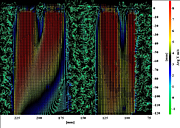- Number 320 |
- September 13, 2010
INL's MIR facility helps engineers improve their designs
Computer-generated velocity
vectors describe the flow of
oil around quartz models
inside Idaho National
Laboratory’s Matched Index
of Refraction facility, the
largest such facility in the world.
(Click image for larger view.)
At Idaho National Laboratory’s Matched Index of Refraction facility, scientists measure how fluids flow around the complex contours of everything from buildings to nuclear reactor cores. They do so by submerging scale models made of quartz in 2,500 gallons of mineral oil.
At room temperature, mineral oil and quartz both bend light waves to the same degree. So when the MIR team lowers their model into the goop, it disappears.
MIR’s ability to make objects disappear lets scientists test and validate their computational flow dynamics (CFD) models and helps engineers maximize the safety and efficiency of their designs. For example, MIR scientists have been helping INL’s Next Generation Nuclear Plant engineers model how coolant will flow through the NGNP's core.
Researchers drop their quartz models into MIR's glass-walled test section and seed the oil with thousands of tiny, silver-coated glass balls. Pumps recirculate the oil, and cameras snap photos as laser light reflects off the silver spheres. Computer algorithms then analyze the pictures to reveal details of the spheres' — and thus the oil's — movement.
A single picture from MIR's cameras can map out more than 7,000 velocity vectors. It may take several months to analyze all that data, on top of 12 to 18 months to design the experiment and build the perfect scale model. But the time investment is well worth it for the unmatched quality of data that MIR experiments deliver.
"You can't just stick a probe into the core of a nuclear reactor," says INL's Hugh McIlroy, who runs MIR. "And even if you could, you wouldn't want to build the reactor without validating your models first."[Nicole Stricker, 208.526.5955,
nicole.stricker@inl.gov]

